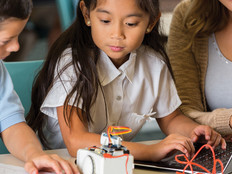Weather Channel: Using Skype in the Classroom
Video conferencing uses a range of audio and video telecommunications technologies to bring people in different locations together both aurally and visually for meetings and other collaborations. In 2003, the market evolved to make way for Skype, a free software application that allows people to make voice and video calls and chat over the Internet.
Earlier this year, Skype formalized a community through which teachers can collaborate with other teachers on projects that might incorporate Skype, share methodologies, or find partner classes and guest speakers. As one of the first beta-testers for Skype in the classroom, I proposed a “Weather Around the World” lesson for students and teachers to engage in using Skype. This lesson plan summarizes the core elements of this collaborative online learning activity.
Lesson Description
Learning about local weather patterns can be fun and exciting. But learning about the weather happening in other parts of the world can be even more so. Many students have never been through a tornado, tsunami or snowstorm and could benefit from hearing people around the world who have witnessed such phenomena recount their experiences. Skype offers a convenient way to connect with them.
To begin this lesson, set up a Skype in the classroom account.
Next, click on the Projects tab (and then the green “Create a Project” button) to enter your weather unit idea. Other teachers who have joined the Skype in the classroom community will see your idea and contact you if they would like to have their class participate in your project. Or, you can use the online community’s search function to seek out teachers in certain countries with whom you would like to collaborate on a weather-related lesson, or even teachers of certain subjects or grades.
Once four or more teachers have agreed to participate in your project via Skype, create a wiki through which students and teachers will share and contribute content as the project progresses. (The wiki I created for my class’s Weather Around the World unit can help you get started.)
Have each participating class research summer, fall, winter and spring weather patterns in their area (including storm types and frequency) and add that information to the project wiki. Give participating students and teachers as much time as they need to gather and submit this data.
After all classes have recorded their findings, divide each class into small groups and assign each group its own wiki. That way, all students will be able to contribute the information they’ve gathered to the overall project.
When all participants have shared their findings on the wikis, contact the other teachers to schedule your Skype session. It’s ideal to schedule one large conference call for all participants, but this may not be possible if classrooms are scattered all over the world, in different time zones. You can also schedule several Skype sessions with the various classes participating in the project, if that’s most convenient.
Once your class has Skyped with all of the other classes participating in the project, have all students add to the project wiki the information they learned from fellow students.
Subject Area
This activity focuses on science subject matter and can be adapted for all grades.
Curriculum Standards
This lesson meets many of the National Educational Technology Standards for Students set forth by the International Society for Technology in Education, which challenge students to:
- interact, collaborate and publish with peers, experts or others employing a variety of digital environments and media (ISTE 2a);
- communicate information and ideas effectively to multiple audiences using a variety of media and formats (ISTE 2b);
- develop cultural understanding and global awareness by engaging with learners of other cultures (ISTE 2c);
- locate, organize, analyze, evaluate, synthesize and ethically use information from a variety of sources and media (ISTE 3b); and
- process data and report results (ISTE 3d).
Resources
- Skype in the classroom: education.skype.com
- “Weather Around the World” wiki: weatherstudy.wikispaces.com
- “50 Awesome Ways to Use Skype in the Classroom”: teachingdegree.org/2009/06/30/50-awesome-ways-to-use-skype-in-the-classroom/
Grading Rubric
Students should be evaluated on the quality of the information that they contributed to the wiki. Factors to consider during this assessment might include information accuracy, scope of their contributions to the wiki and overall communication among schools.
Teaching Tips
- Assign students jobs to perform during the Skype sessions. These jobs might include blogger, director, interviewer, video recorder or photographer.
- Record all Skype sessions so students can watch them again later, if desired.
- Have a backup weather-related lesson ready in case the Internet connection is down or other technology is malfunctioning on the day of your scheduled Skype session.






